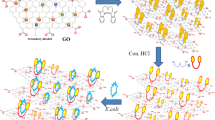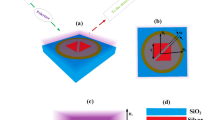Abstract
This paper present graphene based metasurface circular resonator (MSCR) inspired optical sensors for detecting waterborne bacteria such as E. coli, Vibrio Cholera, and Shigella flexneri. The optimal design is achieved through simulating all possible combination of proposed structure and analysis based on evaluation metrices. In this study, we have investigated four different sensors and among these sensors other variations are also examined by varying the graphene chemical potential to finalize the structure. The sensor design also takes into account cost-effectiveness, ease of use, and scalability to ensure the widespread adoption of the technology. The proposed designs consist of one central circle surrounded by multiple circles that increase in number with each design. These designs provide a larger surface area for bacterial adhesion, leading to increased detection sensitivity. The MSCR designs can be easily fabricated using standard techniques and can be modified to detect other types of bacteria or contaminants by changing the surface chemistry.













Similar content being viewed by others
Availability of Data and Materials
The data supporting the findings in this work are available from the corresponding author with a reasonable request.
References
Karpagam KB, Ganesh B (2020) Leptospirosis: a neglected tropical zoonotic infection of public health importance—an updated review. Eur J Clin Microbiol Infect Dis 39(5):835–846. https://doi.org/10.1007/s10096-019-03797-4
Cissé G (2019) Food-borne and water-borne diseases under climate change in low- and middle-income countries: Further efforts needed for reducing environmental health exposure risks. Acta Trop 194(July 2018):181–188. https://doi.org/10.1016/j.actatropica.2019.03.012
Bonadonna L, La Rosa G (2019) A review and update on waterborne viral diseases associated with swimming pools. Int J Environ Res Public Health 16(2):1–11. https://doi.org/10.3390/ijerph16020166
Ramírez-Castillo FY et al (2015) Waterborne pathogens: Detection methods and challenges. Pathogens 4(2):307–334. https://doi.org/10.3390/pathogens4020307
Panda A, Pukhrambam (2021) Investigation of defect based 1D photonic crystal structure for real-time detection of waterborne bacteria. Phys B Condens Matter 607(January):412854. https://doi.org/10.1016/j.physb.2021.412854
Wu Y, Wang CW, Wang D, Wei N (2021) A Whole-Cell Biosensor for Point-of-Care Detection of Waterborne Bacterial Pathogens. ACS Synth Biol 10(2):333–344. https://doi.org/10.1021/acssynbio.0c00491
Jiang Y, Wu J (2019) Recent development in chitosan nanocomposites for surface-based biosensor applications. Electrophoresis 40(16):2084–2097. https://doi.org/10.1002/elps.201900066
Daher MG et al (2022) Detection of Basal Cancer Cells using Photodetector Based on a Novel Surface Plasmon Resonance Nanostructure Employing Perovskite Layer with an Ultra High Sensitivity. Plasmonics. https://doi.org/10.1007/s11468-022-01727-3
Bayat F, Didar TF, Hosseinidoust Z (2021) Emerging investigator series: bacteriophages as nano engineering tools for quality monitoring and pathogen detection in water and wastewater. Environ Sci Nano 8(2):367–389. https://doi.org/10.1039/d0en00962h
Aliakbar Ahovan Z, Hashemi A, De Plano LM, Gholipourmalekabadi M, Seifalian A (2020) Bacteriophage based biosensors: Trends, outcomes and challenges. Nanomaterials 10(3). https://doi.org/10.3390/nano10030501
Marembo L (2020) A Graduated Approach in the Abolition of Waterborne Diseases in Drinking Water Using an Indicator Based Approach and Nano Based Biosensors: A Review. J Environ Earth Sci Gandy 2011:64–71. https://doi.org/10.7176/jees/10-3-07
Razmi N, Hasanzadeh M, Willander M, Nur O (2020) Recent progress on the electrochemical biosensing of Escherichia coli O157:H7: Material and methods overview. Biosensors 10(5). https://doi.org/10.3390/BIOS10050054
Parwez K, Budihal SV (2019) Optimisation of carbon nanotubes for advanced diagnosis and biomedical application. Int J Nanoparticles 11(3):217–238. https://doi.org/10.1504/IJNP.2019.102602
Kotsiri Z, Vidic J, Vantarakis A (2022) Applications of biosensors for bacteria and virus detection in food and water–A systematic review. J Environ Sci (China) 111:367–379. https://doi.org/10.1016/j.jes.2021.04.009
Phinzi K, Ngetar NS (2019) The assessment of water-borne erosion at catchment level using GIS-based RUSLE and remote sensing: A review. Int Soil Water Conserv Res 7(1):27–46. https://doi.org/10.1016/j.iswcr.2018.12.002
Yin R et al (2022) Universal ultra-sensitive refractive index sensor based on an integrated SiO2 asymmetric Mach-Zehnder interference filter (AMZIF). Meas J Int Meas Confed 188. https://doi.org/10.1016/j.measurement.2021.110578
Ahmed W, Kitajima M, Tandukar S, Haramoto E (2020) Recycled water safety: Current status of traditional and emerging viral indicators. Curr Opin Environ Sci Heal 16:62–72. https://doi.org/10.1016/j.coesh.2020.02.009
Moser F, Tham E, González LM, Lu TK, Voigt CA (2019) Light-Controlled, High-Resolution Patterning of Living Engineered Bacteria Onto Textiles, Ceramics, and Plastic. Adv Funct Mater 29(30):1–11. https://doi.org/10.1002/adfm.201901788
Chauhan M, Kumar Singh V (2021) Review on recent experimental SPR/LSPR based fiber optic analyte sensors. Opt Fiber Technol 64(January):102580. https://doi.org/10.1016/j.yofte.2021.102580
Aliqab K, Uniyal A, Srivastava G, Muduli A, Alsharari M, Armghan A (2023) A Theoretical Analysis of Refractive Index Sensor with Improved Sensitivity using Titanium Dioxide, Graphene, and Antimonene Grating: Pseudomonas Bacteria Detection. Measurement p. 112957. https://doi.org/10.1016/j.measurement.2023.112957
Dwivedi N, Dhand C, Kumar P, Srivastava AK (2021) Emergent 2D materials for combating infectious diseases: The potential of MXenes and MXene-graphene composites to fight against pandemics. Mater Adv 2(9):2892–2905. https://doi.org/10.1039/d1ma00003a
Rose L, Mary XA, Johnson I, Srinivasan G, Priya L, Bhagavathsingh J (2021) Polyaza functionalized graphene oxide nanomaterial based sensor for Escherichia coli detection in water matrices. Sci Rep 11(1):1–11. https://doi.org/10.1038/s41598-021-96539-6
Zubiarrain-Laserna A, Kruse P (2020) Review—Graphene-Based Water Quality Sensors. J Electrochem Soc 167(3):37539. https://doi.org/10.1149/1945-7111/ab67a5
Patel SK, Surve J, Parmar J (2022) Detection of cancer with graphene metasurface-based highly efficient sensors. Diam Relat Mater 129:109367. https://doi.org/10.1016/j.diamond.2022.109367
Surve J, Patel SK, Parmar J (2022) Design of Cost-Efficient Graphene Metasurface based Pregnancy Test with NOR Gate Realization and Parametric Optimization. IEEE Sens J pp 1–1. https://doi.org/10.1109/JSEN.2022.3218797
Almawgani AHM et al (2023) A Graphene-Metasurface-Inspired Optical Sensor for the Heavy Metals Detection for Efficient and Rapid Water Treatment. Photonics 10(1):56. https://doi.org/10.3390/photonics10010056
Patel SK, Surve J, Htay MM, Alsalman O, Parmar J, Nguyen TK (2023) Graphene Metasurface Inspired Cyanide Detecting Sensor with Encoding capabilities of Two, Three, and Four Bits. IEEE Sens J pp. 1–1. https://doi.org/10.1109/JSEN.2023.3265673
Patel SK, Surve J, Parmar J, Aliqab K, Alsharari M, Armghan A (2023) SARS-CoV-2 detecting rapid metasurface-based sensor. Diam Relat Mater 132:109644. https://doi.org/10.1016/j.diamond.2022.109644
Sadeqi A, Sonkusale S (2017) Low-cost metamaterial-on-paper chemical sensor. Transducers 2017 - 19th International Conference on Solid-State Sensors, Actuators and Microsystems 25(14):1437–1440. https://doi.org/10.1109/TRANSDUCERS.2017.7994329
Daher MG, Taya SA, Colak I, Ramahi OM (2022) Design of a novel optical sensor for the detection of waterborne bacteria based on a photonic crystal with an ultra-high sensitivity. Opt Quantum Electron 54(2):108. https://doi.org/10.1007/s11082-021-03486-7
Aly AH, Awasthi SK, Mohaseb MA, Matar ZS, Amin AF (2022) MATLAB Simulation-Based Theoretical Study for Detection of a Wide Range of Pathogens Using 1D Defective Photonic Structure. Crystals 12(2):1–10. https://doi.org/10.3390/cryst12020220
Shalaby AS et al (2021) Theoretical study of one-dimensional defect photonic crystal as a high-performance sensor for water-borne bacteria. Opt Quantum Electron 53(11). https://doi.org/10.1007/s11082-021-03291-2
Taya SA, Alhamss DN, Colak I, Patel SK (2022) Sensitivity enhancement of an optical sensor based on a binary photonic crystal for the detection of Escherichia coli by controlling the central wavelength and the angle of incidence. Opt Quantum Electron 54(2). https://doi.org/10.1007/s11082-022-03511-3
Zhao WM, Wang Q (2019) A high sensitivity refractive index sensor based on three-level gradient structure S-tapered fiber mode-mode interferometer. Meas J Int Meas Confed 139:49–60. https://doi.org/10.1016/j.measurement.2019.03.018
Acknowledgements
Researchers Supporting Project number (RSPD2023R654), King Saud University, Riyadh, Saudi Arabia.
Funding
Researchers Supporting Project number (RSPD2023R654), King Saud University, Riyadh, Saudi Arabia.
Author information
Authors and Affiliations
Contributions
“Conceptualization, Osamah Alsalman, Shobhit K. Patel; Methodology, Osamah Alsalman, Shobhit K. Patel and Jacobe Wekaleo; Software, Jacob Wekalao, Jaymit Surve and Shobhit K. Patel; Validation, N.K. Anushkannan and Juveriya Parmar; writing—original draft preparation, All Authors; writing—review and editing, All Authors; All authors have read and agreed to the published version of the manuscript.”
Corresponding author
Ethics declarations
Ethical Approval
Not applicable.
Competing Interests
Not applicable.
Additional information
Publisher's Note
Springer Nature remains neutral with regard to jurisdictional claims in published maps and institutional affiliations.
Rights and permissions
Springer Nature or its licensor (e.g. a society or other partner) holds exclusive rights to this article under a publishing agreement with the author(s) or other rightsholder(s); author self-archiving of the accepted manuscript version of this article is solely governed by the terms of such publishing agreement and applicable law.
About this article
Cite this article
Wekalao, J., Patel, S.K., Alsalman, O. et al. Waterborne Bacteria Detecting Highly Sensitive Graphene Metasurface Based Cost-Efficient and Efficient Refractive Index Sensors. Plasmonics 19, 347–361 (2024). https://doi.org/10.1007/s11468-023-01983-x
Received:
Accepted:
Published:
Issue Date:
DOI: https://doi.org/10.1007/s11468-023-01983-x




